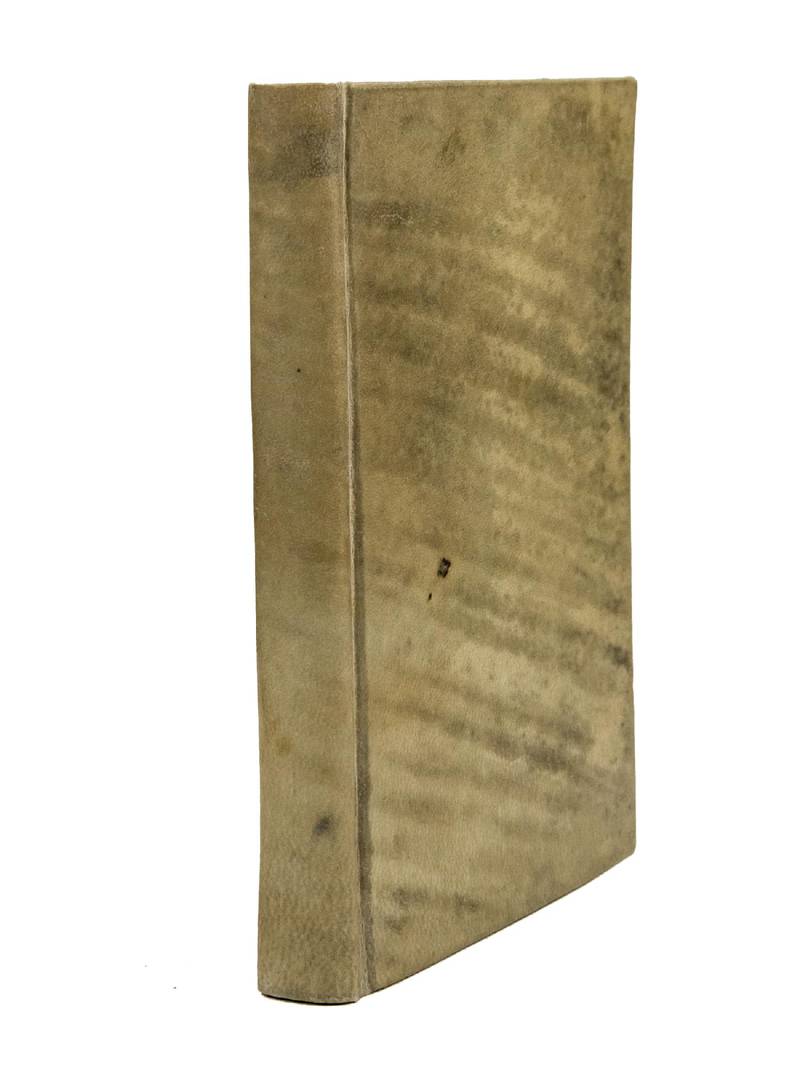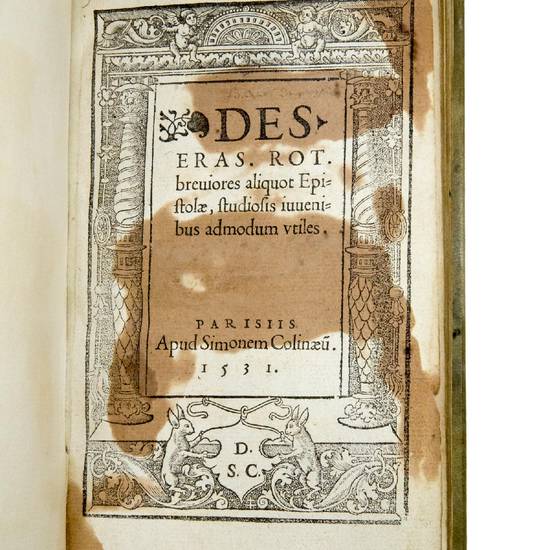8vo. 130 leaves. A-P8, Q10. Title within a woodcut border. Old vellum.
Adams E-558; Index Aureliensis, 152.590; C. Coppens, Erasmiana Lovaniensia: catalogus van de Erasmus-tentoonstelling in de Centrale Bibliotheek te Leuven, november-december 1986, (Louvain, 1986), p. 117, no. 39; F. van der Haegen, Bibliotheca Erasmiana, I, (Gand, 1893), p. 100; Ph. Renouard, Bibliographie des Éditions de Simon de Colines, 1520-1546, (Paris, 1894), no. 177.
THIS unauthorized selection of 227 letters from the correspondence of Erasmus first came out from the presses of Simon de Colines on April 22, 1523. The letters were extracted from two earlier volumes of Erasmus' correspondence: Farrago nova epistolarum (1519) and Epistolae ad diversos (Basel, 1521).
The work was propably intended as illustration of Erasmus manuals of letter writing: “Toutes ces éditions ont un caractère commun: elles sont subreptices. Érasme ne les a pas reconnues. Il aurait jamais accepté la publication, dans ces nouveaux recueils, de la lettre à Pierre Paludanus, qu'il considérait comme une impudente forgerie. En outre, les imprimeurs parisiens Colines et Grosmors seront vigoureusement dénoncés par Érasme pour leurs éditions non autorisées de ses oeuvres” (L.-E. Halkin, Erasmus ex Erasmo: Erasme éditeur de sa correspondence, Aubel, 1983, pp. 133-135; see also A. Vanautgaerden, Anatomie des vanités: Erasme et ses imprimeurs, Bruxelles, 2008, pp. 3-5).
“Le caractère scolaire de ces petits livres ne saurait faire de doute. Comme l'annoncent leurs titres, il s'agit de lettres relativement courtes, d'où leur nombre important (227 ou 225) pour des volumes assez minces (111 à 143 feuillets in 8); la plus longue est la lettre à Spalatin du 7 août 1519 qui occupe un peu plus de quatre pages; la plupart sont extrèmement courtes. La rhétorique de la Renaissance est regardée le plus souvent comme un art du développement; il est rassurant de voir prônes ici le raccourci élégant, la formule rapide et brillante, la litote; et quel meilleur maître pouvait-on trouver qu'Erasme en ce domaine? Le mépris de toute chronologie est commun à ces recueils et à la Farrago aussi bien qu'aux Epistolae ad diversos; il témoigne du dédain de tout intérêt historique. Aussi bien n'est-ce pas la teneur des lettres qui compte, mais leur style. Pour la même raison sans doute - ou peut-être aussi en hommage au grand homme -, seule les lettres d'Erasme ont été retenues, et l'on ne trouve pas ici les réponses des correspondants; l'unique exception est constituée par l'échange de très courts billets entre Erasme et Fausto Andrelini où, pour garder au bref dialogue sa saveur, on a cité les réponses d'Andrelini. Ansi les recueils parisiens rendent-ils hommage à la limpidité légère et acérée du style érasmien” (M.M. de la Garanderie, Recueils parisiens de lettres d'Erasme, in: “Bibliothèque d'Humanisme et Renaissance”,31/3, 1969, p. 455-456).
Gerrit Gerritszoon (better known as Desiderius Erasmus) was born at Rotterdam, apparently on October 28, 1466, the illegitimate son of a physician's daughter and a future monk. At Deventer he attended the local school run by the German humanist Alexander Hegius, learning Latin and Greek. On his parents' death he entered the Augustinian College of Stein near Gouda, where he spent six years. At length the Bishop of Cambrai, Henry of Bergen, made him his private secretary. In order to allow him to accept that post, he was given a temporary dispensation from his monastic vows, dispensation that later was made permanent by Pope Leo X.
After taking priest's orders Erasmus went to Paris, where he studied at the Collège Montaigu. He resided there until 1498, gaining a livelihood by teaching. Among his pupils was Lord Mountjoy, on whose invitation probably Erasmus made his first visit to England in 1498. He lived chiefly at Oxford, making the acquaintance of John Colet and Thomas More.
In 1500 he was again in France, living for the next six years mainly at Paris. During this period he wrote the Adagia (Paris, 1500) and the Enchiridion Militis Christiani (Antwerp, 1503). After a short visit to England, in 1506 Erasmus carried out a long-desired journey to Italy, staying chiefly at Padua as tutor to Alexander Stewart, Archbishop of St. Andrews, and Venice, collaborating to the publishing house of Aldo Manuzio. His visit closed with a short stay in Rome.
In 1509 the accession of Henry VIII and the invitation of Lord Mountjoy induced Erasmus once more to settle in England. In this period he wrote the famous Encomium Moriae (first published at Strasbourg or Paris in 1511) and resided mainly at Cambridge, where he was appointed Margaret professor of Divinity and professor of Greek.
After 1514 he lived alternatively in Basel and England, and from 1517 to 1521 at Louvain. In 1516 at Basel appeared the first edition of the Colloquia, usually regarded as his masterpiece, and the first edition of his annotated New Testament. After the explosion of Lutheran revolution, he found himself in the most embarrassing position, assailed on the one side by the Catholic who considered him as the cause of all the new troubles, and criticized on the other side by the Lutherans who accused him for his cowardice and inconsistency in refusing to follow up his opinions to their legitimate conclusions.
In 1521 he left Louvain, where the champions of the old faith had made his stay unendurable and, with the exception of six years in Freiburg, he spent the rest of his life at Basel. In those years he continued publishing a long succession of classical and patristic writers, as well as new augmented and corrected editions of his main works, especially the Adagia, the Colloquia and his epistolary. At the same time he was engaged in continual controversies, on the one side with Protestants thinkers like Ulrich von Hutten and Martin Luther, with whom he exchanged a series of pamphlets about the free will (starting with Erasmus' De Libero Arbitrio, Antwerp, 1524), on the other side with the Catholic theologians of the Sorbonne.
With the publication of the dialogue Ciceronianus (Basel, 1528), he then ruined some old friendships, like that with Guillaume Budé, and raised against himself new adversaries, those humanists, namely, who he accused to set style above matter. Nevertheless during his last years Erasmus enjoyed great fame and consideration all over Europe. He died at Basel on July 12, 1536 and was buried there in the cathedral (cf. C. Augustijn, Erasmus: His Life, Works, and Influence, Toronto, 1991; J. McConica, Erasmus, Oxford, 1991; and L.-E. Halkin, Erasmus: A Critical Biography, Oxford, 1993).
[9148]





